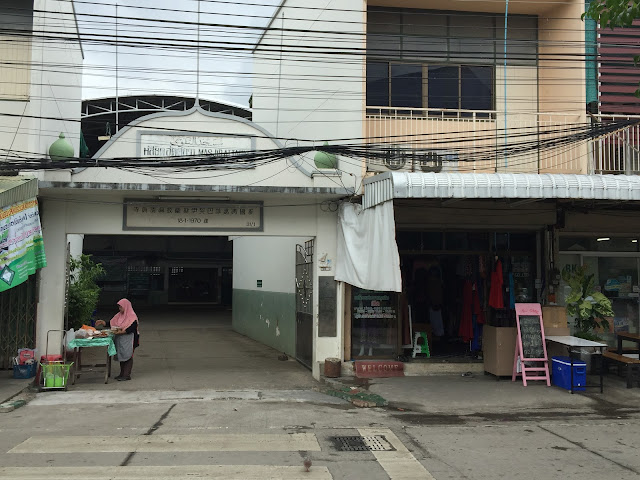Survey of Attaqwa Mosque in Chiangmai
Attaqwa mosque, located on the opposite side of the Ping River not too far from the Ban Ho mosque, was established in 1970, much later than the Ban Ho mosque. Before coming to Chiangmai, I had come across the Attaqwa mosque in a memoir by Dr. Zhao Xilin that I acquired in Taipei, in a section that recounts his encounter in Mecca with Hu Ranmao. Mr. Hu is described in the memoir as the main benefactor who enthusiastically initiated building of the Attaqwa Islamic School by the mosque, with some assistance from the World Muslim League in Mecca. The people whom I talked to in Ban Ho mosque were well aware of the name Hu Ranmao: he was a quite wealthy person who built the Attaqwa mosque because the Ban Ho mosque could no longer accommodate the increasing number of users of the Ban Ho mosque.
 |
| Entrance to the Attaqwa Mosque and inside |
Detailed stories behind the building of Attaqwa mosque await further conversations next week, so this post will mostly contain photos I took on Thursday afternoon and Friday morning when I briefly visited the mosque. In contrast to Thursday afternoon when almost no one was present, on early Friday morning the mosque and its vicinity were packed with people who had arrived to celebrate the 'Eid.
Despite the absence of people, I could notice from the signs and buildings that communal activities were taking place in the mosque -- collection of communal welfare funds, association of Muslim women, and a school right across from the mosque which also seemed to have dormitory facilities.
 |
| Facilities and associations around Attaqwa Mosque |
Inside the school building across the mosque itself, one side of the wall displayed several photos and a brief explanation about the mosque in Thai and Arabic languages.
From what I know, the person on the most left of the three photos is Hu Ranmao.
 |
| Displayed on one side of the wall past the entrance of Attaqwa Islamic school |
The last section of the plate explains that the land was purchased for the purpose of building schools and housing (for teachers and renters), with contributions from a group of Muslim brothers and followers of Islam, from the countries mentioned in the plate. The purchase of the land and construction of buildings cost about 10,000,000 (10 million) Baht. Sixty percent of the contributions came from outside, and the rest of the forty percent within the Kingdom of Thailand. The whole group, according to the plate, refused to have their full names written down. Their countries, however, were:
1. Saudi Arabia (المملكة العربية السعودية )
2. Libya (الجماهير العربية الليبية)
3. Tunisia (الجمهورية العربية التونسية)
4. Qatar (دولة قطر)
5. U.A.E., specifically Dubai ((دولة الإمارات (دبي)
6. Kuwait (دولة الكويت)
7. China (الصين)
8. Thailand (المملكة التايلاندية)
The writing of the plate is dated 28 Muharram, 1403 hijri calendar, which would be equivalent to some time in October, 1982.
During the two visits I was able to schedule a meeting next week with a teacher who has worked at the mosque for the past forty years. Periodicals published in Taipei (Zhongguo Huijiao) during the mosque's initial period also seem to carry articles on it. These, combined, will hopefully open up fascinating histories behind the mosque's building and the networks which it has been a part of.










Comments
Post a Comment